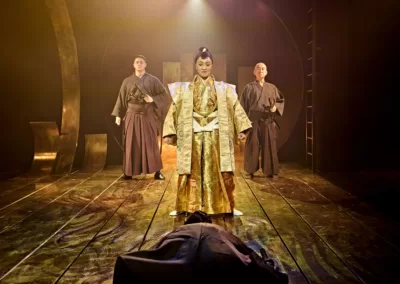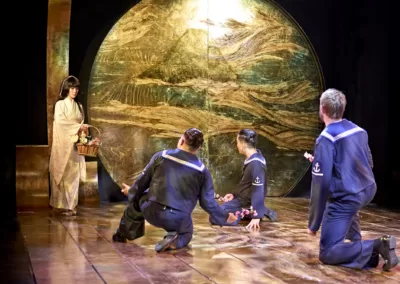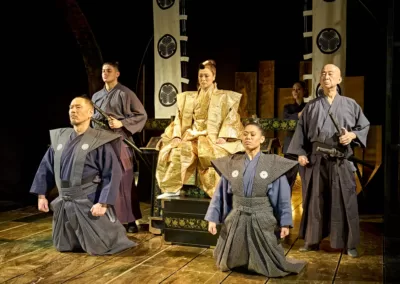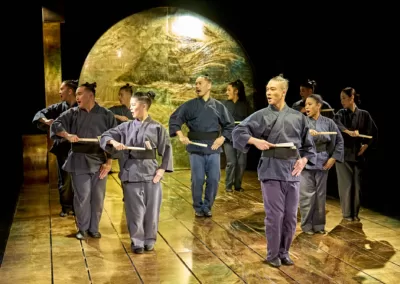Show: Pacific Overtures
Society: London (professional shows)
Venue: Menier Chocolate Factory. 53 Southwark Street, London SE1 1RU
Credits: Music & Lyrics Stephen Sondheim. Book by John Weidman. Additional material Hugh Wheeler. Directed Matthew White. Presented by Menier Chocolate Factory co-produced with Umeda Arts Theater.
Pacific Overture
4 stars
Until 1853 Japan was an Island in the sea which had kept out “barbarian foreigners” since the seventeenth century. They were a peaceful people who grew rice and painted screens. Then four American warships turned up to make “Pacific overtures”, aggressive ones if necessary, and things changed very quickly.
That’s the history which inspired this American musical, dating from 1976, which tells a very human story entirely from the point of view of the Japanese. It has been pared down, over the years, to highlight the serious, often tragic, nature of the narrative and this engaging new production, which first ran in Tokyo and Osaka earlier this year, runs for I hour 45 mins without interval.
It has always been specified that the cast should be Japanese and most of this cast have Pacific heritage although many of them trained at UK drama schools. The production was originally played in Japanese. At the Chocolate Factory it’s in English, with one neat little joke when the cast apparently forgets and has to be switched back.
The man who does the switching is Jon Chew, the narrator who, remote video control in hand, presents the story as if it were an illustrated lecture. And it’s a splendid performance. He struts, hops and dances about, catching the eyes of audience members, watches the set pieces from the sidelines and is charismatically convincing. We believe what he says. Occasionally he becomes part of the action. He is very adept in including the entire audience as he speaks. The Menier is configured in a traverse format for this production and Chew handles that expertly.
It’s a big cast of seventeen with some enjoyably energetic ensemble work. Saori Oda is excellent as the Shogun, initially very formal but gradually thawing as the situation becomes tenser. She is also delightful as the saucy, knowing, Madame supervising her “girls” and pragmatically seeing good business opportunities in the arrival of foreigners. And that encapsulates the tragedy of this tale. How are foreign sailors to tell which women are prostitutes and which aren’t in this culture so different from their own? The scene in which Luoran Ding is an exotically pretty woman in an orchard where she is propositioned with money by three eager but pretty harmless young Brits is devastating because her honour is ruthlessly defended by the men who guard her. And that’s based on a real historical incident.
The scene in which boats begin to turn up from all over the world hungry for exploitative trade opportunities is a richly entertaining, beautifully written series of stereotypical pastiches. Patrick Munday gives us a British Admiral singing a take-off of a G&S patter song. Lee VG makes his bass voice sound straight from the Volga as he accelerates in true Russian folk-style. And Sario Soloman is hilarious and an absurdly over-the-top, show-stealing French admiral.
Paul Farnsworth’s set does clever things with a big circular screen, looking like a rising sun to connote Japan, or maybe a world map, at one end which splits vertically as doors. It often frames scenes such as the Shogun’s court too. Ayako’s imaginative costumes range from kimonos to silly hats for Admirals and outfits which include boats and national flags. From the technical point of view, however, the best thing is Paul Pyant’s evocative lighting – bright for an orchard, blood red for horror and delicate light patterns on the floor.
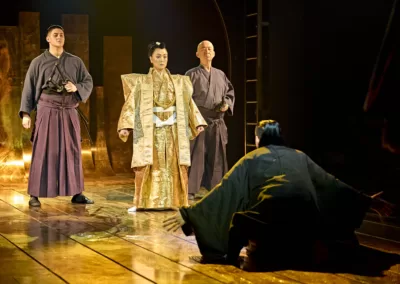
And it’s all accompanied/led by Paul Bogaev’s fine nine piece band, just visible on a corner balcony. A lot of the music is very subtle – the Pretty Lady number, for example develops into a very attractive fugal piece. And Sondheim isn’t above the classic but always effective trick in which you use the pentatonic scale, rather than the usual Western eight note one, to make a melody sound Japanese.
I know that to criticise Sondheim is as crass as finding fault with Leonardo da Vinci or Mozart but, as always with his shows, I found myself wondering whether the music needs to be quite so repetitive. I’m not at all convinced that every reprise actually adds something. And most of the numbers (there are only ten in the whole show) are quite long and sometimes feel protracted.
My other little gripe, in what really is a fine show generally, is my usual problem with stage smoke. And there’s a great deal of it when the first American boats arrive. Yes, I know it’s theatrically effective, lighting designers love it and actors sing through it without a problem but – even though it’s meant to be completely harmless – it makes me cough. Perhaps I am a freak but there it is. We exist.
First published by Sardines https://www.sardinesmagazine.co.uk/review/pacific-overtures/
